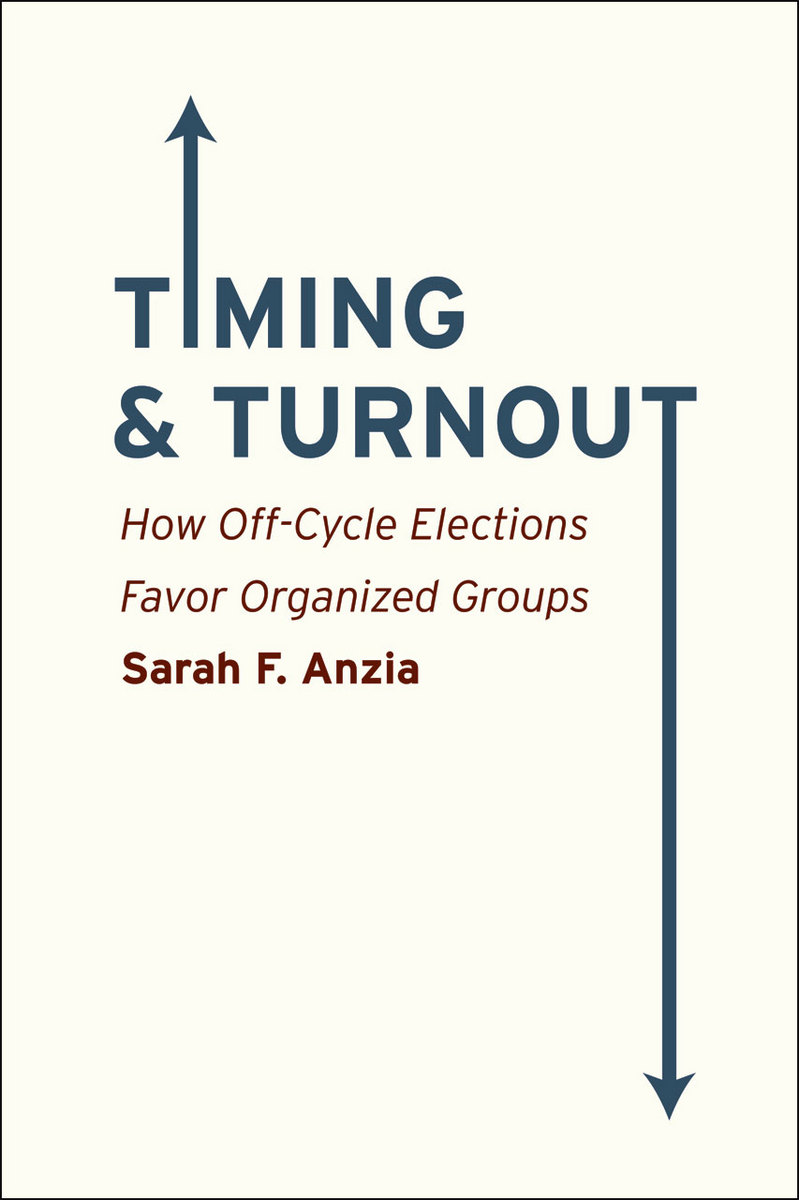Timing and Turnout
How Off-Cycle Elections Favor Organized Groups
University of Chicago Press, 2013
Cloth: 978-0-226-08678-1 | Paper: 978-0-226-08681-1 | Electronic: 978-0-226-08695-8
DOI: 10.7208/chicago/9780226086958.001.0001
Cloth: 978-0-226-08678-1 | Paper: 978-0-226-08681-1 | Electronic: 978-0-226-08695-8
DOI: 10.7208/chicago/9780226086958.001.0001
AVAILABLE FROM
University of Chicago Press (cloth, paper, ebook)Amazon Kindle
Barnes & Noble Nook
Chegg Inc
ebrary
EBSCO eBooks (formerly NetLibrary)
Google Play
Kno
ABOUT THIS BOOKAUTHOR BIOGRAPHYREVIEWSTABLE OF CONTENTS
ABOUT THIS BOOK
Public policy in the United States is the product of decisions made by more than 500,000 elected officials, and the vast majority of those officials are elected on days other than Election Day. And because far fewer voters turn out for off-cycle elections, that means the majority of officials in America are elected by a politically motivated minority of Americans. Sarah F. Anzia is the first to systemically address the effects of election timing on political outcomes, and her findings are eye-opening.
The low turnout for off-cycle elections, Anzia argues, increases the influence of organized interest groups like teachers’ unions and municipal workers. While such groups tend to vote at high rates regardless of when the election is held, the low turnout in off-cycle years enhances the effectiveness of their mobilization efforts and makes them a proportionately larger bloc. Throughout American history, the issue of election timing has been a contentious one. Anzia’s book traces efforts by interest groups and political parties to change the timing of elections to their advantage, resulting in the electoral structures we have today. Ultimately, what might seem at first glance to be mundane matters of scheduling are better understood as tactics designed to distribute political power, determining who has an advantage in the electoral process and who will control government at the municipal, county, and state levels.
AUTHOR BIOGRAPHY
Sarah F. Anzia is assistant professor of public policy at the Goldman School of Public Policy at the University of California, Berkeley. She lives in Berkeley, CA.
REVIEWS
“Political scientists have long lamented the crazy-quilt pattern of American elections but few have systematically studied its effects. In this sharp and careful study, Sarah F. Anzia convincingly demonstrates how oddly timed elections benefit politically organized groups. Timing and Turnout is a valuable addition to the burgeoning literature on local elections.”
— Eric Oliver, University of Chicago, author of Local Elections and the Politics of Small Scale Democracy"Timing and Turnout offers an authoritative account of the causes and consequences of election timing. Progressive-era reformers argued—and many good-government types today still believe—that separating the timing of local from national elections improves the quality of American local democracy. In a trenchant analysis, Sarah F. Anzia debunks the conventional wisdom, demonstrating how off-cycle elections reduce voter turnout and amplify the power of organized interest groups. Our democracy suffers as a result."
— Stephen P. Erie, University of California, San Diego“Anzia focuses on a grossly underexamined issue in the study of US politics: the timing of elections. Most are aware that Election Day is the first Tuesday after the first Monday in November in even numbered years, but few political scientists devote any attention to the many elections that occur off-cycle. . . . In this impressive study, Anzia kickstarts the process of rectifying this oversight. . . . Anyone interested in US elections should read this book. Essential.”
— Choice“A vast literature has asked whether direct democracy, voter registration laws, nonpartisan elections, and even ballot appearance influence voter participation. However, political scientists have tended to ignore the one institutional arrangement that is the most powerful predictor of turnout: the day an election is held. Anzia’s Timing and Turnout offers the first comprehensive account of the causes and consequences of “off-cycle” elections in the United States. . . . Two strengths of the book are its careful attention to causal identification and the fact that Anzia tests her theoretical framework in a variety of contexts across both time and space.”
— Political Science Quarterly"An outstanding book.”
— FiveThirtyEightTABLE OF CONTENTS
List of Illustrations
Acknowledgments
1. Timing and Turnout: The Basics
2. A Theory of Election Timing
3. Partisan Power Play: Election Timing Politics in the Nineteenth Century
4. Interest Groups and Election Timing Choice in the Twenty-First Century
5. Estimating the Effect of Off-Cycle Election Timing: School Board Elections
6. "What Election?" : Timing, Turnout, and Policy in California Cities
7. Implications for Democracy, Representation, and Institutional Stability
Appendixes
Notes
Index
